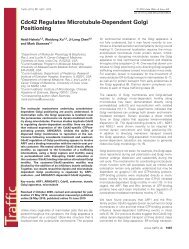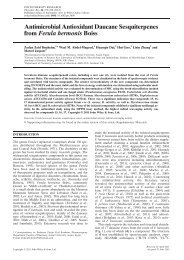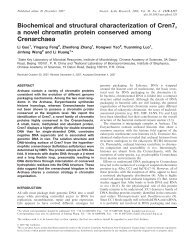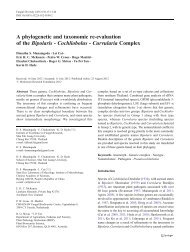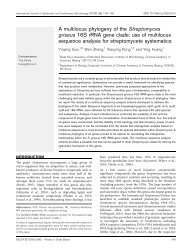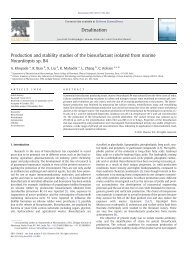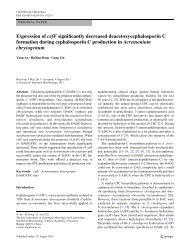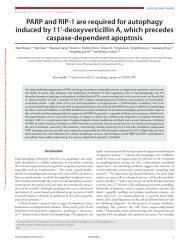Purification and characterization of four keratinases ... - ResearchGate
Purification and characterization of four keratinases ... - ResearchGate
Purification and characterization of four keratinases ... - ResearchGate
You also want an ePaper? Increase the reach of your titles
YUMPU automatically turns print PDFs into web optimized ePapers that Google loves.
F. Xie et al. / Bioresource Technology 101 (2010) 344–350 345<br />
from Streptomyces sp. strain 16 could also efficiently decompose<br />
casein, collagen, <strong>and</strong> keratin azure.<br />
In this study, we describe the purification <strong>and</strong> <strong>characterization</strong><br />
<strong>of</strong> <strong>four</strong> <strong>keratinases</strong> from Streptomyces sp. strain 16 cultured in<br />
medium containing NHFS.<br />
2. Methods<br />
2.1. Materials<br />
Native human foot skin waste was collected from the foot care<br />
section <strong>of</strong> the Haidian Hospital in Beijing. In preparation for NHFS<br />
experiments, the human foot skin was washed thoroughly with tap<br />
water, autoclaved, <strong>and</strong> then dried. The dried NHFS was stored under<br />
dry condition <strong>and</strong> was used for keratinase production. One part <strong>of</strong> the<br />
dried NHFS was milled to powders for the keratinase assay. 1-Ethyl-<br />
3-(3-dimethyaminopropyl) carbodiimide (EDAC), p-chloromercuribenzoic<br />
acid (pCMB), phenylmethanesulfonyl fluoride (PMSF), DLdithiothreitol<br />
(DTT), <strong>and</strong> casein were purchased from Sigma (USA).<br />
Nanosep centrifugal device tubes (molecular size cut<strong>of</strong>f, 100 or<br />
10 kDa) were purchased from Pall Corporation (USA), while Sephacryl<br />
S-200 resin, Superose 12 10/300 GL column, Hiprep DEAE FF<br />
column (1 ml), <strong>and</strong> Hiprep Octyl FF column (1 ml) were acquired<br />
from Amersham Biosciences (Sweden). The Folin–Ciocalteu reagent<br />
was purchased from Dingguo Company (China). All reagents used<br />
in this study were analytical grade unless otherwise indicated.<br />
2.2. Microorganism, culture medium, <strong>and</strong> growth conditions<br />
The microorganism used in this study was Streptomyces sp.<br />
strain 16, which was isolated in our lab for keratinase production<br />
(Chao et al., 2007). The medium for keratinase production was<br />
composed <strong>of</strong> NHFS, 4 g/l; soluble starch, 5 g/l; yeast extract, 1 g/l;<br />
<strong>and</strong> K 2 HPO 4 , 0.5 g/l. The pH <strong>of</strong> the medium was 8.0.<br />
Seed cultures <strong>of</strong> Streptomyces sp. strain 16 were prepared in a<br />
500 ml Erlenmeyer flask containing 100 ml <strong>of</strong> culture medium.<br />
After 2 days <strong>of</strong> incubation, the culture broth was transferred to a<br />
5 L Fernbach culture flask containing 1.5 L <strong>of</strong> medium for <strong>keratinases</strong><br />
production. After 4 days <strong>of</strong> incubation, the culture was collected<br />
for keratinase purification. All incubations were done<br />
aerobically at 30 °C on an orbital platform shaker at 200 rpm.<br />
2.3. Zymography <strong>of</strong> the culture filtrate<br />
The zymography <strong>of</strong> the culture filtrate was based on the method<br />
<strong>of</strong> Bressollier et al. (1999).The culture broth was centrifuged<br />
(10,000 rpm, 4 °C, 10 min.), <strong>and</strong> the supernatant was mixed with<br />
2 electrophoresis sample buffer (2 ml 4 stacking gel buffer,<br />
1.6 ml glycerol, 3.2 ml 10% SDS, 0.8 ml 2-mercaptoethanol, <strong>and</strong><br />
0.4 ml 1.0% bromophenol blue) (Simpson, 2003) in a 1:1 ratio without<br />
heat denaturation. SDS–PAGE was carried out at 4 °C with a<br />
constant current <strong>of</strong> 23 mA in a 12% polyacrylamide gel. The gel<br />
was washed with 2.5% Triton X-100 (v/v) in 50 mM Tris–HCl buffer<br />
(pH 7.5) for 30 min. Then washed with 50 mM Tris–HCl buffer (pH<br />
7.5) for 30 min. Casein (1%, w/v) dissolved in 50 mM Tris–HCl buffer<br />
(pH 7.5) was poured onto the gel. After 30 min at 40 °C, the gel<br />
was stained with Coomassie brilliant blue R-250 <strong>and</strong> then destained<br />
with a water/methanol/acetic acid (50:40:10) solvent. Peptidase<br />
b<strong>and</strong>s appeared as clear zones on a blue background.<br />
2.4. Enzyme assays<br />
2.4.1. Assay for keratinolytic activity<br />
Keratinolytic activity was determined spectrophotometrically<br />
with a modification <strong>of</strong> the Folin–Ciocalteu method (Ledoux <strong>and</strong><br />
Lamy, 1986; Margesin <strong>and</strong> Schinner, 1991). An appropriate amount<br />
<strong>of</strong> enzyme was incubated with 1.5 ml <strong>of</strong> 0.5% sieved (mesh size:<br />
300 lm) NHFS, in 50 mM Tris–HCl buffer (pH 7.5) at 40 °C for<br />
16 h. The reaction was terminated with 3 ml <strong>of</strong> 10% trichloroacetic<br />
acid (TCA) <strong>and</strong> placed at room temperature for 30 min. The reaction<br />
mixture was centrifuged, <strong>and</strong> 5 ml <strong>of</strong> 0.55 M Na 2 CO 3 was<br />
added to 1 ml <strong>of</strong> the supernatant, with subsequent addition <strong>of</strong><br />
1 ml Folin–Ciocalteu reagent. This mixture was incubated at<br />
40 °C for 15 min. Keratinolytic activity was measured at 680 nm<br />
using a spectrophotometer (721 Visible Spectrometry, China).<br />
One unit (U) <strong>of</strong> keratinase activity was represented by an increase<br />
in absorbance at 680 nm <strong>of</strong> 0.01 in 1 h compared with the control<br />
reaction. The control was treated in the same way, except that TCA<br />
was added before incubation.<br />
2.4.2. Assay for proteolytic activity<br />
Protease activity was determined by modifying the Folin–Ciocalteu<br />
method using casein as a substrate. The appropriate amount<br />
<strong>of</strong> enzyme was incubated with 1 ml 1% casein in 50 mM Tris–HCl<br />
buffer (pH 7.5) at 40 °C for 15 min. The reaction was terminated<br />
by the addition <strong>of</strong> 3 ml <strong>of</strong> 10% TCA. Subsequent steps were the<br />
same as those described in the assay <strong>of</strong> keratinolytic activity.<br />
One unit (U) <strong>of</strong> protease activity was defined as an increase in<br />
absorbance at 680 nm <strong>of</strong> 0.01 in 1 min compared with the control<br />
reaction. The control was treated in the same way, except that TCA<br />
was added before incubation.<br />
2.5. Protein determination<br />
Protein concentrations <strong>of</strong> the enzyme preparations were determined<br />
according to the method described by Bradford (1976),<br />
using bovine serum albumin as the st<strong>and</strong>ard.<br />
2.6. <strong>Purification</strong> procedure<br />
Culture broth was centrifuged (11,366g, 4°C, 10 min) to remove<br />
cells <strong>and</strong> debris <strong>and</strong> the supernatant was collected. Solid<br />
ammonium sulfate was added to the supernatant with a saturation<br />
<strong>of</strong> 80% under gentle stirring, <strong>and</strong> then kept at 4 °C overnight. The<br />
suspension was centrifuged at 10,000g for 30 min at 4 °C. The<br />
precipitate was then dissolved in 100 ml <strong>of</strong> 50 mM Tris–HCl buffer<br />
(pH 7.5).<br />
Three milliliter <strong>of</strong> the dissolved ammonium sulfate precipitate<br />
was loaded onto a Sephacryl S-200 column (3 100 cm) equilibrated<br />
with 50 mM Tris–HCl buffer (pH 7.5) <strong>and</strong> eluted with the<br />
same buffer at a flow rate <strong>of</strong> 0.5 ml/min. Fractions <strong>of</strong> 6.0 ml in each<br />
tube were collected <strong>and</strong> assayed for keratinolytic activity. The<br />
peaks with keratinolytic activity were named KI, KII, KIII, <strong>and</strong> KIV<br />
according to the order <strong>of</strong> elution. Purity was checked via SDS–<br />
PAGE. KIV was found to be homogenous on the SDS–PAGE gel,<br />
while the other three components needed further chromatographic<br />
purification.<br />
2.6.1. <strong>Purification</strong> <strong>of</strong> <strong>keratinases</strong> KI <strong>and</strong> KII<br />
Following Sephacryl S-200 column chromatography, the KI <strong>and</strong><br />
KII fractions were pooled separately, <strong>and</strong> sequentially applied to a<br />
Hiprep DEAE FF column (1 ml) pre-equilibrated in 50 mM Tris–HCl<br />
buffer (pH 7.5), <strong>and</strong> a Hiprep Octyl FF column (1 ml) pre-equilibrated<br />
in 50 mM Tris–HCl buffer (pH 7.5) containing 1.5 M<br />
(NH 4 ) 2 SO 4 . The KI fraction was eluted from the Hiprep DEAE FF column<br />
with 20 ml 50 mM Tris–HCl buffer (pH 7.5) containing 0 to<br />
1 M NaCl at a linear flow rate <strong>of</strong> 2 ml/min. The KII fraction was<br />
eluted using 0.1 M, 0.2 M, 0.5 M, <strong>and</strong> 1 M NaCl sequentially, in<br />
50 mM Tris–HCl buffer (pH 7.5). The KI fraction was eluted from<br />
the Hiprep Octyl FF column using 20 ml <strong>of</strong> 50 mM Tris–HCl buffer<br />
(pH 7.5) containing 0 to 1.5 M (NH 4 ) 2 SO 4 at a linear flow rate <strong>of</strong>





